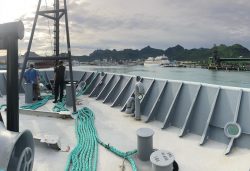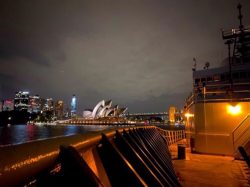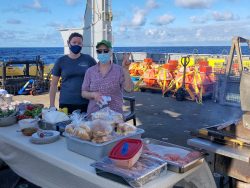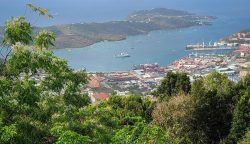For crew members of the UW research vessel Thomas G. Thompson, the last two years have been a test of preparedness and resilience while conducting research at sea. On top of the usual threats of rough seas and homesickness, seafarers now have to factor in the worldwide coronavirus pandemic, which has had a special knack for spreading rapidly on ships.
While the isolated nature of research on the open ocean might have seemed like welcome distance from the rest of humanity during the early days of the pandemic, many will remember how some of the first stories of the virus’ potential came from shipboard outbreaks. Ships can be dangerous places when disease is spreading, as quarters are close, and there are no doctors or emergency rooms to turn to when you’re in the middle of the ocean.
The pandemic emerges

When news of COVID-19 first broke in January 2020, the Thompson was in Cape Town, South Africa. The crew had just had a suspected outbreak of norovirus, which was precariously timed. “I’m really happy that we had that [norovirus] before the stories about COVID broke internationally, otherwise we might have been sent away,” said Port Captain Meegan Corcoran. The ship then traveled to the Indian Ocean, stopping at Mauritius in early March. The crew that joined the ship in Mauritius was subject to additional health screening, but was allowed into the country and onto the boat. That would be the last routine stop.
The Thompson left Mauritius on a 27-day transit to Fiji, passing under Australia. During those 27 days, the world changed dramatically. While near Hobart, Tasmania, the captain was told by the National Science Foundation and US Navy that they must return to the US immediately. Within two days of that, Fiji shut their borders and would not allow the ship to dock. With supplies and fuel running low, Corcoran said, “we were asking ‘well, how are we going to get back?’”

Thankfully, a connection in Sydney arranged for an emergency port call. Nobody was allowed on or off the ship, but they were able to pick up food and fuel.
While the crew longed to be back at their home port at the University of Washington, Seattle seemed to be one of the most dangerous places to go due to the high level of COVID transmission in the area. The ship eventually headed to US waters in Honolulu, where the crew was kept onboard for three weeks awaiting further instruction. “Something like this had never happened before, and we didn’t quite know what to do,” Corcoran said. But finally, as case rates began to drop stateside, the ship was allowed back to Seattle to dock, returning home after a cruise of 823 days.
COVID safety at sea is a moving target

As the state of the pandemic became clearer and the ship was docked, they needed to develop new health protocols to get ahead of new risks. The crew met and discussed what measures they would like to take — would the ship allow the crew to visit family and friends, and then return to the boat? “We’re much more like a democracy on the ship,” Corcoran said. “Ship culture is delicate, and we have to ensure every voice is being heard or things can fall apart quickly.” Eventually, the crew agreed that they would follow strict protocols. The ship would be isolated from the outside world, and anyone coming or going would need to quarantine and test frequently. “We’re constantly talking about it, and it is a moving target,” said Corcoran. “A new variant can blow everything out of the water and change our plans.”
“Pre-COVID, port calls were a time the crew would look forward to as a break in the action and an occasion to explore,” said Relief Captain Christine Klimkowski, the first female captain of the Thompson. “Since the beginning of the pandemic, we have all been restricted to staying on the ship … and it is tough to be next to a beautiful island and not be able to go ashore or to the beach.” Along with staying onboard, the global reach of the Thompson was reduced, with the ship remaining near North America and only docking at US ports. Conveniently, the ship found nearby research opportunities off the Oregon coast for the summer of 2020, and came into dry dock for overhaul in the fall and winter.

Science teams and crew typically come on and off the boat prior to setting sail, but are now required to complete a quarantine period before every research cruise. Adding this extra hurdle on top of already busy research schedules was a challenge, not to mention the psychological toll of extended isolation. However, some crew liked the quiet. “I think some members quite enjoyed the quarantine process,” Klimkowski said. “People embraced the time as a bit of a retreat and did things like taking an online class, working on their hobbies or just relaxing.”
“You get paid well for hanging out just to be sure you don’t have COVID,” Corcoran added. “That certainly helps.”
Easing restrictions
Border policies and health precautions for the crew were not the only disruptions on board. The disturbance to the global supply chain was felt on the ship as well, which required creative solutions. While the Thompson usually received “store deliveries” of eight to twelve pallets of food and supplies on a tractor trailer, the suppliers had trouble recruiting drivers and taking on new orders to fulfill the Thompson’s needs. “Fred Meyer has been the solution!” Klimkowski said. “They have been able to fulfill several smaller orders each time we come into port.”

In the summer of 2021, increased availability of COVID-19 vaccines promised to mitigate the impacts of the disease. Vaccination clinics for the dozens of shipboard crew members were set up at St. Thomas, U.S. Virgin Islands, and later for a second dose at Woods Hole Oceanographic Institute in Massachusetts. The clinics were held on the dock in order to maintain the ship’s “bubble.” With vaccines came more freedom, allowing crew to go ashore for outdoor recreation or personal shopping, but still forbade going to bars, restaurants or other public gatherings. “Part of being a mariner is getting to explore,” Corcoran said, “and the pandemic is honestly pretty hard when you want to experience different cuisines and cultures.”
A new normal
Despite the challenges, many of the crew still relish their time at sea. “Landlubbers would be surprised by the simple things,” Klimkowski said. “How truly blue the open ocean can be, the dramatic sunrises and sunsets, the seabirds, marine mammals, fish, squid and jellyfish, the night sky with no light pollution.”
The Thompson remains ready for COVID cases onboard with an isolation room and testing kits. However, as of January 2021, they have not had to use it, making the Thompson rare among large research ships in having no cases or outbreaks. What has led to the success? “Our testing scheme has been so tight, we catch people before they come onboard,” Corcoran explained. “And it is because our crew has full buy-in and we talk to them when we make decisions.”
Currently, the Thompson is located 600 miles south of the Galapagos Islands. You can track it here.

